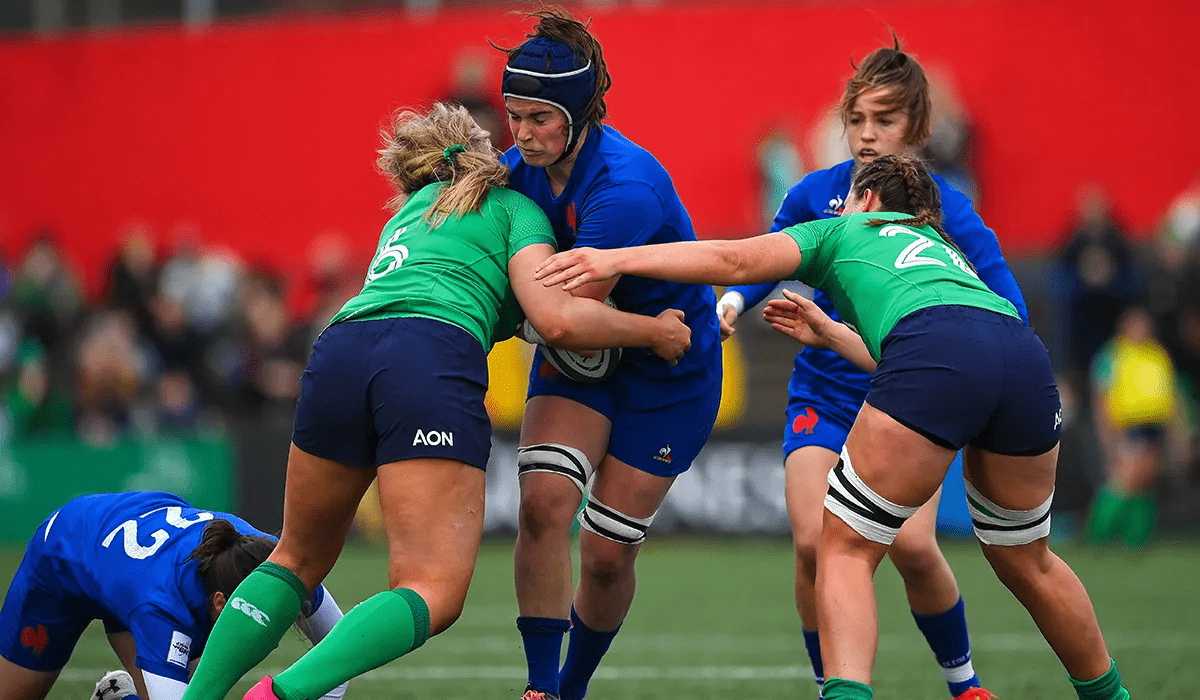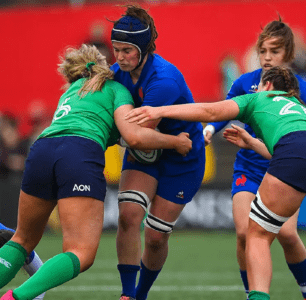Rugby defense involves preventing the opposing team from scoring by stopping their advances and regaining possession of the ball. It requires teamwork, communication, and effective tackling to neutralize threats.
Learn about the essential principles and techniques of defense in women’s rugby, including teamwork, communication, and tackling strategies to thwart the opponent’s attacks.
Defence FAQ
- What is the role of the fullback in rugby defense?
- What is the role of the winger in defending against wide attacks?
Wingers play a crucial role in defending against wide attacks by using their speed and agility to cover their assigned area, preventing opposition wingers or attackers from exploiting space on the flanks. They must also contribute to the defensive line when needed and make effective tackles.
- What does drift defense mean?
Drift defense is a tactic where defenders slide horizontally across the field, rather than aggressively rushing up, to cover attacking players and close down space. It aims to maintain defensive integrity, forcing attackers towards the touchline and limiting their options.
- What are the common mistakes to avoid in rugby defense?
Common defensive mistakes include poor communication, drifting out of the defensive line, incorrect tackling technique, overcommitting to tackles or rucks, and failing to reset quickly after turnovers. Maintaining discipline and focus is crucial to avoid these errors.
- What are the different defensive formations used in rugby?
Defensive formations vary based on team strategy and game situations but commonly include systems like the flat line, umbrella defense, blitz defense, and drift defense. Each formation has its strengths and weaknesses, and teams may switch between them as needed during a match.
- What is the importance of maintaining line integrity in defense?
Maintaining line integrity ensures that defenders cover space effectively, reducing the chances of attackers finding gaps or exploiting mismatches. It also allows for coordinated defensive efforts, where players can trust their teammates to fulfill their roles and responsibilities within the system.
- What is the offside line in rugby defense?
The offside line marks the point beyond which defending players must retreat to be onside. It is typically formed at the hindmost foot of the ruck, maul, or tackled player. Players cannot participate in the game until they are behind the offside line, ensuring fair play and contest at the breakdown.
- What is the primary goal of defending in rugby?
The primary goal of defending in rugby is to prevent the opposing team from scoring points by maintaining a strong defensive structure, making effective tackles, and forcing turnovers. It requires teamwork, discipline, and adaptability to counter the various attacking strategies employed by the opposition.
- How do players communicate and organize themselves defensively on the field?
Communication and organization are key aspects of defensive play in rugby. Players use verbal cues, hand signals, and pre-defined defensive structures to communicate and coordinate their movements effectively. This includes assigning specific roles to players, such as marking attackers or covering defensive channels, to ensure cohesive defensive coverage across the field. Adaptability and awareness of the game situation are also essential in organizing effective defensive strategies.
- What is the significance of the gain line in defense?
The gain line, which represents the point on the field where the attacking team gains or loses territory, is crucial in defense. Defending teams aim to prevent the attacking team from crossing the gain line with each phase of play. By holding the opposition behind the gain line, defenders can apply pressure, force turnovers, and limit the attacking team’s options, ultimately disrupting their momentum and preventing them from advancing down the field.
- How do players create and exploit gaps in the opposing defense during an attack?
Players create and exploit gaps by using strategies such as running lines, drawing defenders out of position with dummy runs or passes, and executing well-timed offloads to support players. Quick decision-making, communication, and understanding of defensive patterns are key.
- How does the blitz defense tactic work in rugby?
The blitz defense tactic involves aggressive, coordinated pressure on the attacking team, aiming to disrupt their play and force errors. Defenders rush up quickly in a line, aiming to close down space and put pressure on the ball carrier, often relying on communication and timing.
- How does the defensive line work in rugby?
The defensive line works as a cohesive unit to prevent the opposition from advancing. Players communicate to ensure they cover space effectively, with each player responsible for marking an attacker. The line moves up or shifts laterally based on the ball’s movement to maintain pressure.
- What are the key principles of effective rugby defense?
Effective rugby defense relies on principles such as line speed, communication, tackling technique, maintaining defensive shape, and adaptability. Players must work together to anticipate and react to the attacking team’s movements while minimizing gaps and vulnerabilities in the defense.
- What is the role of the fullback in an attacking situation?

